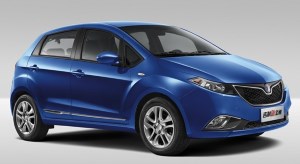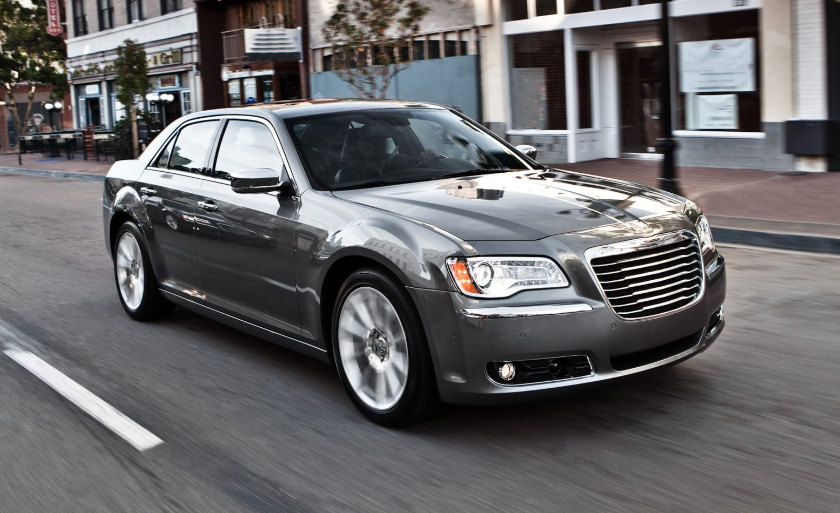I’m not the biggest fan of the Nissan Bluebird, but a milestone happened earlier this month that a lot of the motoring press seems to have missed: the demise of this 53-year-old nameplate.
Starting in 1959, Bluebird has been a mainstay of the Nissan line-up, and even when the traditional Bluebird line finished in its home country in 2001, Nissan kept the name going with the Bluebird Sylphy, a car based around the Pulsar.
This month, with the third-generation Sylphy launching in Japan, after its release in China and Thailand, the Bluebird name disappeared—which had been expected, if you examine the evolution of Japanese (and many American) model names. Celica Camry gave way to Camry; Corona Premio gave way to Premio; Chevelle Malibu gave way to Malibu.
So as a tribute to the Bluebird, here are all the ones that are on Autocade. Diehard Nissan fans, of course, know that the lineage continues in a way—the Altima line is directly derived from the Bluebird’s, and is its spiritual successor.
 Datsun Bluebird/YLN 704 (310/311/312/DP311/DP312). 1959–63 (prod. n/a). 4-door sedan, 5-door wagon. F/R, 988, 1189 cm³ (4 cyl. OHV). Akiro Sato-styled range, giving Datsun a more contemporary-looking entrant, but still with Anglo influences. More competitive than upright 210, and the first Datsun notching up some decent numbers in export markets. Hugely improved ride and handling. Semi-monocoque body. Larger 1·2 (48 hp) still similar to BMC B-series, which had powered Austins that Nissan built under licence, created to head off Volkswagen Käfer, which was doing well in the US. Wagon from 1960, automatic from 1961.
Datsun Bluebird/YLN 704 (310/311/312/DP311/DP312). 1959–63 (prod. n/a). 4-door sedan, 5-door wagon. F/R, 988, 1189 cm³ (4 cyl. OHV). Akiro Sato-styled range, giving Datsun a more contemporary-looking entrant, but still with Anglo influences. More competitive than upright 210, and the first Datsun notching up some decent numbers in export markets. Hugely improved ride and handling. Semi-monocoque body. Larger 1·2 (48 hp) still similar to BMC B-series, which had powered Austins that Nissan built under licence, created to head off Volkswagen Käfer, which was doing well in the US. Wagon from 1960, automatic from 1961.
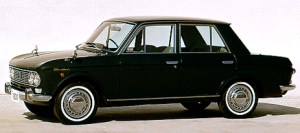 Nissan Bluebird/YLN 705B (410/411). 1963–7 (prod. n/a). 2- and 4-door sedan, 5-door wagon. F/R, 988, 1189, 1299 cm³ (4 cyl. OHV), 1595 cm³ (4 cyl. OHC). If the 310 saw export success, then the 410 broke those records convincingly. Pininfarina styling was more globally appealing, especially in the US, and, at home, Bluebird overtook its arch-rival, the Toyopet Corona (T40), in sales. Lighter than predecessor, monocoque construction, longer wheelbase, shorter front and rear overhangs. Carryover engines initially. SS sport sedan in 1964, similar to Deluxe but with two 38 mm Hitachi side-draught carburettors, taking power to 65 hp, and four-speed gearbox. Two-door models in 1964; facelift later that year. In 1965, 411 series, with minor cosmetic changes. SSS (twin SU carbs, 90 hp, 1·6 from Fairlady) from 1965, starting a Bluebird tradition that would last till the line’s demise. Further minor changes in 1966. Range included a Fancy Deluxe model, supposedly targeted at women. Built in Taiwan by Yue Loong as YLN 705B.
Nissan Bluebird/YLN 705B (410/411). 1963–7 (prod. n/a). 2- and 4-door sedan, 5-door wagon. F/R, 988, 1189, 1299 cm³ (4 cyl. OHV), 1595 cm³ (4 cyl. OHC). If the 310 saw export success, then the 410 broke those records convincingly. Pininfarina styling was more globally appealing, especially in the US, and, at home, Bluebird overtook its arch-rival, the Toyopet Corona (T40), in sales. Lighter than predecessor, monocoque construction, longer wheelbase, shorter front and rear overhangs. Carryover engines initially. SS sport sedan in 1964, similar to Deluxe but with two 38 mm Hitachi side-draught carburettors, taking power to 65 hp, and four-speed gearbox. Two-door models in 1964; facelift later that year. In 1965, 411 series, with minor cosmetic changes. SSS (twin SU carbs, 90 hp, 1·6 from Fairlady) from 1965, starting a Bluebird tradition that would last till the line’s demise. Further minor changes in 1966. Range included a Fancy Deluxe model, supposedly targeted at women. Built in Taiwan by Yue Loong as YLN 705B.
 Nissan Bluebird/YLN 706 (510). 1967–72 (prod. unknown). 2- and 4-door sedan, 5-door wagon, 2-door coupé. F/R, 1296, 1428, 1595, 1770 cm³ (4 cyl. OHC). Most famous of all the Bluebirds, thanks to modern OHC engines, excellent performance, and competition history. Four-wheel independent suspension—the first for a Nissan. Moved upmarket to accommodate introduction of Sunny in 1966. Seen as more advanced than rival Toyopet Corona (T40). Minor changes to grille in October 1968, coupé added the following month. Largest 1·8 added in 1970 for Bluebird SSS. Remained in production even after launch of larger Bluebird in 1971, after which the Nissan Violet filled the role of a smaller mid-size car. Exported as Datsun 510 or Datsun 1600.
Nissan Bluebird/YLN 706 (510). 1967–72 (prod. unknown). 2- and 4-door sedan, 5-door wagon, 2-door coupé. F/R, 1296, 1428, 1595, 1770 cm³ (4 cyl. OHC). Most famous of all the Bluebirds, thanks to modern OHC engines, excellent performance, and competition history. Four-wheel independent suspension—the first for a Nissan. Moved upmarket to accommodate introduction of Sunny in 1966. Seen as more advanced than rival Toyopet Corona (T40). Minor changes to grille in October 1968, coupé added the following month. Largest 1·8 added in 1970 for Bluebird SSS. Remained in production even after launch of larger Bluebird in 1971, after which the Nissan Violet filled the role of a smaller mid-size car. Exported as Datsun 510 or Datsun 1600.
 Nissan Bluebird U (610). 1971–6 (prod. unknown). 4-door sedan, 2-door coupé, 5-door wagon. F/R, 1595, 1770, 1952 cm³ (4 cyl. OHC). Bluebird U replaced successful 510 series, which ran alongside for the first year. Not as well loved, with performance emphasis gone, in favour of interior equipment and mid-Atlantic styling. Performance 1800 SSS model from May 1972, with five-speed gearbox; mid-term changes 1973. Two-litre from August 1973, with longer front end. Usually exported as Datsun 160B, 180B and 200B depending on engine size; South Africa called this the Datsun 180U.
Nissan Bluebird U (610). 1971–6 (prod. unknown). 4-door sedan, 2-door coupé, 5-door wagon. F/R, 1595, 1770, 1952 cm³ (4 cyl. OHC). Bluebird U replaced successful 510 series, which ran alongside for the first year. Not as well loved, with performance emphasis gone, in favour of interior equipment and mid-Atlantic styling. Performance 1800 SSS model from May 1972, with five-speed gearbox; mid-term changes 1973. Two-litre from August 1973, with longer front end. Usually exported as Datsun 160B, 180B and 200B depending on engine size; South Africa called this the Datsun 180U.
 Nissan Bluebird/Datsun 200B (810). 1976–81 (prod. unknown). 4-door sedan, 5-door wagon, 2-door coupé. F/R, 1595, 1770, 1952 cm³ (4 cyl. OHC), 2143, 2393 cm³ (6 cyl. OHC). Bloated replacement for U series, evolving its predecessor’s styling, mixing sharp angles with a slight coke-bottle. Marketed in 1976 as a heavy-duty car in Japan, and the concept stuck. Not that successful in the home market with the second fuel crisis looming and its mixture of fours and sixes, though sold relatively well abroad. Built also in Australia (from 1978) as Datsun 200B, and exported from Japan to most countries as 160B, 180B and 200B, but called 810 in the US. Long-nose G6 versions housed straight sixes, while the sheetmetal was later used on long-nose G4s with the four-cylinder units after the mid-term facelift in 1978. Twentieth anniversary of the Bluebird nameplate 1979, with special commemorative edition. Production ceased in Japan in 1979, making it the shortest-lived Bluebird there, though continued in Australia to 1981.
Nissan Bluebird/Datsun 200B (810). 1976–81 (prod. unknown). 4-door sedan, 5-door wagon, 2-door coupé. F/R, 1595, 1770, 1952 cm³ (4 cyl. OHC), 2143, 2393 cm³ (6 cyl. OHC). Bloated replacement for U series, evolving its predecessor’s styling, mixing sharp angles with a slight coke-bottle. Marketed in 1976 as a heavy-duty car in Japan, and the concept stuck. Not that successful in the home market with the second fuel crisis looming and its mixture of fours and sixes, though sold relatively well abroad. Built also in Australia (from 1978) as Datsun 200B, and exported from Japan to most countries as 160B, 180B and 200B, but called 810 in the US. Long-nose G6 versions housed straight sixes, while the sheetmetal was later used on long-nose G4s with the four-cylinder units after the mid-term facelift in 1978. Twentieth anniversary of the Bluebird nameplate 1979, with special commemorative edition. Production ceased in Japan in 1979, making it the shortest-lived Bluebird there, though continued in Australia to 1981.
 Nissan Bluebird (910). 1979–86 (prod. unknown). 4-door sedan, 5-door wagon, 2-door coupé. F/R, 1595, 1598, 1770, 1809, 1952 cm³ petrol, 1952 cm³ diesel (4 cyl. OHC), 2393 cm³ (6 cyl. OHC). Squared-off Bluebird began Nissan’s 1980s’ rise, dropping its alphanumeric model codes in many markets. Badged Datsun for export initially, with Nissan badges appearing in 1981. Sold in US as 810, 810 Maxima, and then Maxima from 1982. Conventional, despite sharp, boxy styling. End of Japanese production 1983. Facelift in Australia in 1985.
Nissan Bluebird (910). 1979–86 (prod. unknown). 4-door sedan, 5-door wagon, 2-door coupé. F/R, 1595, 1598, 1770, 1809, 1952 cm³ petrol, 1952 cm³ diesel (4 cyl. OHC), 2393 cm³ (6 cyl. OHC). Squared-off Bluebird began Nissan’s 1980s’ rise, dropping its alphanumeric model codes in many markets. Badged Datsun for export initially, with Nissan badges appearing in 1981. Sold in US as 810, 810 Maxima, and then Maxima from 1982. Conventional, despite sharp, boxy styling. End of Japanese production 1983. Facelift in Australia in 1985.
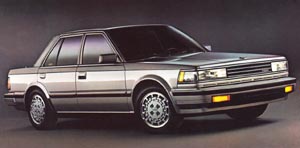 Nissan Bluebird (U11). 1983–90 (prod. unknown). F/F, 1595, 1809, 1960, 1974 cm³ petrol, 1952 cm³ diesel (4 cyl. OHC), 1998, 2960 cm³ (V6 OHC). 4-door sedan, 4-door hardtop sedan, 5-door wagon. Boxy front-drive Bluebird, resembling its predecessor. Stylistically out of step with the rounded styling of the 1980s, yet it was Nissan’s mainstay in the mid-sized sector in many markets. Called Maxima in US, with 3-litre V6 and longer nose similar to home-market hardtops’ and considered sportier than Toyota rivals; other markets made do with smaller engines. Europe received this model for two years until the Nissan Auster (T12) was sold there as the Bluebird from 1985, though the station wagon—lasting into the U12 era—continued there.
Nissan Bluebird (U11). 1983–90 (prod. unknown). F/F, 1595, 1809, 1960, 1974 cm³ petrol, 1952 cm³ diesel (4 cyl. OHC), 1998, 2960 cm³ (V6 OHC). 4-door sedan, 4-door hardtop sedan, 5-door wagon. Boxy front-drive Bluebird, resembling its predecessor. Stylistically out of step with the rounded styling of the 1980s, yet it was Nissan’s mainstay in the mid-sized sector in many markets. Called Maxima in US, with 3-litre V6 and longer nose similar to home-market hardtops’ and considered sportier than Toyota rivals; other markets made do with smaller engines. Europe received this model for two years until the Nissan Auster (T12) was sold there as the Bluebird from 1985, though the station wagon—lasting into the U12 era—continued there.
 Nissan Bluebird (T72). 1987–90 (prod. unknown). 4- and 5-door sedan. F/F, 1598, 1809, 1973 cm³ petrol, 1952 cm³ diesel (4 cyl. OHC). Facelift for British version of Auster, now fully built in the UK. Front slightly smoother than Japanese version, with some concessions to 1980s’ trends, though regarded as a dull, domestic-appliance range. Incredibly reliable, earning it adherents.
Nissan Bluebird (T72). 1987–90 (prod. unknown). 4- and 5-door sedan. F/F, 1598, 1809, 1973 cm³ petrol, 1952 cm³ diesel (4 cyl. OHC). Facelift for British version of Auster, now fully built in the UK. Front slightly smoother than Japanese version, with some concessions to 1980s’ trends, though regarded as a dull, domestic-appliance range. Incredibly reliable, earning it adherents.
 Nissan Bluebird (U12). 1987–91 (prod. unknown). 4-door sedan, 4-door hardtop sedan. F/F, F/A, 1598, 1809, 1973 cm³ petrol, 1952 cm³ diesel (4 cyl. OHC), 1809, 1998 cm³ (4 cyl. DOHC). Nissan concedes that 1980s’ design was more curvy than it insisted upon for U11. Range included four-wheel-drive and turbocharged (1·8 and 2·0) models, as well as ATTESA four-wheel-steering option. SR20DET two-litre turbo engine first appeared on ATTESA SSS model. Australian version, Nissan Pintara, had 2·4-litre option and some were exported to Japan. Sold as Nissan Stanza in US, though unrelated to Stanzas sold in Japan during the 1980s.
Nissan Bluebird (U12). 1987–91 (prod. unknown). 4-door sedan, 4-door hardtop sedan. F/F, F/A, 1598, 1809, 1973 cm³ petrol, 1952 cm³ diesel (4 cyl. OHC), 1809, 1998 cm³ (4 cyl. DOHC). Nissan concedes that 1980s’ design was more curvy than it insisted upon for U11. Range included four-wheel-drive and turbocharged (1·8 and 2·0) models, as well as ATTESA four-wheel-steering option. SR20DET two-litre turbo engine first appeared on ATTESA SSS model. Australian version, Nissan Pintara, had 2·4-litre option and some were exported to Japan. Sold as Nissan Stanza in US, though unrelated to Stanzas sold in Japan during the 1980s.
 Nissan Pintara (U12). 1989–92 (prod. unknown). 4- and 5-door sedan. F/F, 1974, 2389 cm³ (4 cyl. OHC). Huge hype leading up to ‘Project Matilda’ Pintara launch—only to discover it was just an Australianized U12 Bluebird. Dull, and not a unique car that could take on Mitsubishi Magna. Twinned with Ford Corsair (1989–92). One bonus was a Superhatch (Bluebird Aussie in Japan, Bluebird Sporthatch in New Zealand), designed by Nissan Australia, which made the range look appealing. Quality down from Japanese models and relatively few survive. Last Australian Nissan as company exited local production in 1992.
Nissan Pintara (U12). 1989–92 (prod. unknown). 4- and 5-door sedan. F/F, 1974, 2389 cm³ (4 cyl. OHC). Huge hype leading up to ‘Project Matilda’ Pintara launch—only to discover it was just an Australianized U12 Bluebird. Dull, and not a unique car that could take on Mitsubishi Magna. Twinned with Ford Corsair (1989–92). One bonus was a Superhatch (Bluebird Aussie in Japan, Bluebird Sporthatch in New Zealand), designed by Nissan Australia, which made the range look appealing. Quality down from Japanese models and relatively few survive. Last Australian Nissan as company exited local production in 1992.
 Nissan Bluebird (U13). 1991–5 (prod. unknown). 4-door sedan, 4-door hardtop. F/F, F/A, 1597, 1839, 1998, 2388 cm³ (4 cyl. DOHC), 1974 cm³ diesel (4 cyl. OHC). Most curvaceous Bluebird, looking smaller than predecessor, complemented by more formal ARX hardtop. Sedan sold in US (where it was designed) as Nissan Altima. Rounded shape previewed direction of the larger Nissan Leopard J. Ferie. Range included, as before, ATTESA four-wheel-drive models. No wagon. Not that successful in Japan due to rounded styling; fared better on export. Independent rear suspension, with improvements in handling compared with U12. Centre of this model was used for Chinese EQ7200 series.
Nissan Bluebird (U13). 1991–5 (prod. unknown). 4-door sedan, 4-door hardtop. F/F, F/A, 1597, 1839, 1998, 2388 cm³ (4 cyl. DOHC), 1974 cm³ diesel (4 cyl. OHC). Most curvaceous Bluebird, looking smaller than predecessor, complemented by more formal ARX hardtop. Sedan sold in US (where it was designed) as Nissan Altima. Rounded shape previewed direction of the larger Nissan Leopard J. Ferie. Range included, as before, ATTESA four-wheel-drive models. No wagon. Not that successful in Japan due to rounded styling; fared better on export. Independent rear suspension, with improvements in handling compared with U12. Centre of this model was used for Chinese EQ7200 series.
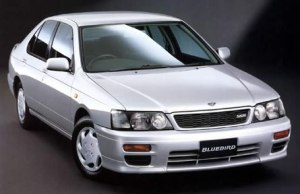 Nissan Bluebird (U14). 1996–2001 (prod. n/a). 4-door sedan. F/F, F/A, 1769, 1838, 1998 cm³ petrol (4 cyl. DOHC), 1973 cm³ diesel (4 cyl. OHC). Dullest Bluebird, the end of a long-running line. No hardtop this time, only a single boxy sedan that was deemed to be the popular, conservative style—but was out of step again with consumer tastes. Shared platform with Nissan Primera (P11), hence a shorter wheelbase and overall length compared with U13. Minor changes in 1997 and 1998, with engine improvements. Fortieth anniversary of Bluebird nameplate in 1999 with limited-edition model. Pulsar-based Sylphy introduced in 2000 as final Bluebirds deleted the following year.
Nissan Bluebird (U14). 1996–2001 (prod. n/a). 4-door sedan. F/F, F/A, 1769, 1838, 1998 cm³ petrol (4 cyl. DOHC), 1973 cm³ diesel (4 cyl. OHC). Dullest Bluebird, the end of a long-running line. No hardtop this time, only a single boxy sedan that was deemed to be the popular, conservative style—but was out of step again with consumer tastes. Shared platform with Nissan Primera (P11), hence a shorter wheelbase and overall length compared with U13. Minor changes in 1997 and 1998, with engine improvements. Fortieth anniversary of Bluebird nameplate in 1999 with limited-edition model. Pulsar-based Sylphy introduced in 2000 as final Bluebirds deleted the following year.
 Nissan Bluebird (EQ7200). 2000–5 (prod. unknown). 4-door sedan. F/F, 1998 cm³ (4 cyl. DOHC). Chinese version of U13 Bluebird but with formal front and rear ends, lengthening car considerably. Built by both Dongfeng Motor Co. (東風 or 东风) and Yulon Motor (YLN, 裕隆). Usual Nissan virtues of a good engine and reliability; less inspiring to drive as model geared toward comfort. Updated to EQ7200-II in 2001, EQ7200-III in 2003 and EQ7200-IV in 2004. Last model to wear the Bluebird name without the Sylphy tag. Electric hybrid version (dubbed HEV) without Nissan or Bluebird names, still being trialled as of 2009.
Nissan Bluebird (EQ7200). 2000–5 (prod. unknown). 4-door sedan. F/F, 1998 cm³ (4 cyl. DOHC). Chinese version of U13 Bluebird but with formal front and rear ends, lengthening car considerably. Built by both Dongfeng Motor Co. (東風 or 东风) and Yulon Motor (YLN, 裕隆). Usual Nissan virtues of a good engine and reliability; less inspiring to drive as model geared toward comfort. Updated to EQ7200-II in 2001, EQ7200-III in 2003 and EQ7200-IV in 2004. Last model to wear the Bluebird name without the Sylphy tag. Electric hybrid version (dubbed HEV) without Nissan or Bluebird names, still being trialled as of 2009.
 Nissan Bluebird Sylphy/Nissan Sunny/Nissan Sunny Neo/Nissan Sentra (G10). 2000 to date (prod. n/a). 4-door sedan. F/F, 1497, 1769, 1998 cm³ (4 cyl. DOHC). Typical Japanese sedan, well engineered but not that inspiring. Effectively a four-door Nissan Pulsar (N16) with luxury appointments and a formal grille, appealing to traditional Japanese buyers. Long-running Bluebird name kept alive, but since it was not part of the same lineage, the Sylphy word was attached. Successful, even selling in modified form in Korea as Samsung SM3 (N17), and exported as Nissan Pulsar to some markets. Japanese production to 2005. Called Sentra in Malaysia, where it was facelifted in 2005 and continued in to the 2010s; Egypt assembled this model as Sunny, later Sunny EX.
Nissan Bluebird Sylphy/Nissan Sunny/Nissan Sunny Neo/Nissan Sentra (G10). 2000 to date (prod. n/a). 4-door sedan. F/F, 1497, 1769, 1998 cm³ (4 cyl. DOHC). Typical Japanese sedan, well engineered but not that inspiring. Effectively a four-door Nissan Pulsar (N16) with luxury appointments and a formal grille, appealing to traditional Japanese buyers. Long-running Bluebird name kept alive, but since it was not part of the same lineage, the Sylphy word was attached. Successful, even selling in modified form in Korea as Samsung SM3 (N17), and exported as Nissan Pulsar to some markets. Japanese production to 2005. Called Sentra in Malaysia, where it was facelifted in 2005 and continued in to the 2010s; Egypt assembled this model as Sunny, later Sunny EX.
 Nissan Bluebird Sylphy (G11). 2005–12 (prod. n/a). 4-door sedan. F/F, 1498, 1997 cm³ (4 cyl. DOHC). Second-generation Sylphy, keeping the Bluebird nameplate, dating from the late 1950s, alive (though in Singapore, the Bluebird tag is missing). Although related to the US-market Nissan Sentra (B16), marketed as a rival to the Toyota Camry and Honda Accord in Taiwan. Very roomy and longer than Sentra—4,610 mm length. As with the Sentra, the Sylphy is on a Renault Mégane II platform. Cast off to China in 2011 as the Dongfeng Fengsheng A60.
Nissan Bluebird Sylphy (G11). 2005–12 (prod. n/a). 4-door sedan. F/F, 1498, 1997 cm³ (4 cyl. DOHC). Second-generation Sylphy, keeping the Bluebird nameplate, dating from the late 1950s, alive (though in Singapore, the Bluebird tag is missing). Although related to the US-market Nissan Sentra (B16), marketed as a rival to the Toyota Camry and Honda Accord in Taiwan. Very roomy and longer than Sentra—4,610 mm length. As with the Sentra, the Sylphy is on a Renault Mégane II platform. Cast off to China in 2011 as the Dongfeng Fengsheng A60.

